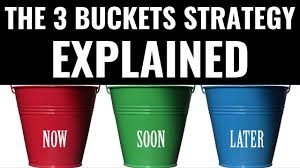My kids have been putting some money aside in a secret hiding spot so they can buy the newest and greatest video game system. Without knowing it, they have been using a type of bucketing system to accomplish their goals. Investopedia defines bucketing for retirement like this: “Bucketing segments funds among different time horizons or risk tolerance bands in order to keep a withdrawal rate that corresponds to time left after retirement. Systematic withdrawal advocates maintaining a fully diversified portfolio that can generate a 4%–5% withdrawal rate each year.” In other words, our money is segmented into different investments that we can withdraw from during different periods of our retirement. Usually there will be a liquid bucket, money that will be used in the next 5 years that is readily available. This would be your safest investments, things such as checking and savings accounts, any funds that you will be living on in the next quarter or year. Other buckets might include low risk investments that would fund your retirement for the next 2 to 10 years; things like fixed income products and balanced investment strategies, like bonds, CDs and simple annuities. You may have another bucket that has more risk but can also attain the biggest growth that you will use in 10 years or more; this might be stocks that are going to be held for 10 years or longer; that way you are not forced to sell the stock during a downturn, you are invested for the long haul.
Jamie Hopkins, the Director of Retirement Research and Managing Director of Carson Coaching and contributor to Forbes.com cites the most often missed bucket in retirement: “Home equity is often forgotten as a potential retirement income source. If you do bucketing correctly and in a holistic manner, your home should be in the plan. And here’s why. For most people, the home is not only a financial asset, but a sentimental asset, too, filled with memories. Many homeowners will hesitate to use equity, downsize or borrow against their home in retirement. A house is also a liability for many people. Housing expenses tend to be the largest expenditure for Americans at over 37% of their budget. So under one roof is an asset that has sentimental value, financial value, a liability aspect and provides shelter, a need everyone has.” Often this bucket is seen as a legacy investment, to be inherited by the next generation or a bucket that will be used to pay for long-term care if needed.
Jason Smith, CEO of Clarity 2 Prosperity explains: “(homeowners) will use home equity lines of credit as a tool to refill a soon or now bucket as essentially an emergency or backup cash flow vehicle. This can provide the cash flow to let buckets and the portfolio refuel and recover in case things had gotten off course.” The challenge with using a Home Equity Line of Credit (HELOC) for this type of bucket refill is the risk. HELOCs are very low cost and the rates are favorable right now, but these loans are not guaranteed. For example, during the 2008 downturn as home values started to drop, banks and credit unions permanently closed access to money in the HELOCs. Some retirees lost their homes because rates and payments had risen and they could no longer afford to make the payments on their HELOCs. So, this strategy is low cost but high risk. Another strategy is low risk but higher cost. The Home Equity Conversion Mortgage (HECM) or reverse mortgage is a loan on the equity in your home that requires no monthly mortgage payments. Your home cannot be sold or taken because there are no required monthly payments. Just as in a traditional loan, the home must be kept in proper repair and property tax and home insurance must be paid by the homeowner. This HECM loan can provide a guaranteed monthly check for life, a lump sum payout to refill some of your retirement buckets, or you may leave in a Line of Credit (LOC). This LOC is different than a HELOC because the HECM LOC cannot be frozen or taken away if home values fall a little or even a lot. This creates a secure way to replenish your buckets if needed with the equity in your home. This product typically lets a senior access between 40 to 75% of their equity depending on age. The main goal is to eliminate the monthly mortgage payment, which will help remove the greatest drain on your retirement funds. Plus it may give you access to additional funds to be used for whatever you need. If stocks drop for a period of time and you were planning on living on that in retirement, draw your funds to live on from your reverse mortgage line of credit. If you wish, once stocks recover you can pay the money back into your RM LOC. If you pay back say $10,000, it will lower the loan amount by $10,000 while at the same time add $10,000 to the money available in your RM LOC! By the way, the money left in the RM LOC has a growth rate that is compounded annually! The typical growth rate is around 3.5%, you won’t find that on a savings account right now.
A HECM Reverse Mortgage is a tool, it is not good or bad, it either enhances a retirement or it doesn’t; looking into one is the only way to know for sure. If you have questions regarding the bucket strategy, please consult your financial advisor. If you have questions regarding a reverse mortgage loan program or would like to see what you or your client qualifies for, you may contact Robert Krepps rkrepps@hightechlending.com or toll-free at 877-567-7476.
Robert Krepps, NMLS #255191, at HighTechLending Inc. HighTechLending Inc, NMLS # 7147, is an Equal Housing Lender. Licensed by the Department of Business Oversight under the California Residential Mortgage Lending Act.


